July 26, 2018
 by Claire Brenner / July 26, 2018
by Claire Brenner / July 26, 2018

Since its launch in 2010, Instagram has taken the social media world by storm.
Its loyal users have closely followed its evolution from a simple photo-sharing app to the massive platform it is today.
With 22 percent of millennials ranking Instagram as their favorite social media platform, it’s no surprise that social media marketing professionals at trendy boutiques and high-end cosmetic companies have flocked to the platform.
Unfortunately, millennials’ favor for Instagram has been both a blessing and a curse. While many marketers are leveraging the photo-sharing network, even more marketing professionals are focusing their efforts elsewhere, based on the assumption that their audience just isn’t there.
Does that sound familiar?
If this is you, I’m going to tell it to you straight: you’re probably wrong, and, even worse, you may be missing out on a massive opportunity.
In this guide to Instagram marketing, we’ll take you through all of the reasons you should be on Instagram. Plus, give you some helpful hints toward building your Instagram strategy, setting objectives, and delivering results.
Tip: Before you go all in on Instagram with your marketing efforts, read what real users have to say about their experience with the photo-sharing app.
Now, let’s get started.
Instagram is a photo and video sharing social networking service originally created for smartphones. Since its inception in 2010, the platform has soared in popularity, especially among millennials.
Instagram marketing is the way that brands use Instagram to connect with their target audiences and market their offerings. Recently, it’s gained popularity as an exciting method for brands to show off their cultures, recruit new employees, engage with customers, and show off products in a new light.
Similar to Facebook and Twitter, everybody who creates an Instagram account has a profile and newsfeed. Users can interact with one another by following, being followed, private messaging, and commenting on or liking photos or videos. The in-app filters and editing options Instagram offers make the app unique because it was the first app to offer in-app editing to this extent.
Instagram allows users to upload photos and videos to their profile and edit them with various options. Instagram hosts dozens of original filters that users can add to their photos. These preset filters make various changes to photos, including adding light, giving the image a warm or cool tone, increasing or decreasing saturation, and much more. Additionally, users can edit images directly in the platform, as opposed to using a third-party photo editor. If they don’t like one particular filter, they can use Instagram’s editing feature, to individually change the contrast, brightness, structure, warmth, saturation, sharpness, and more.
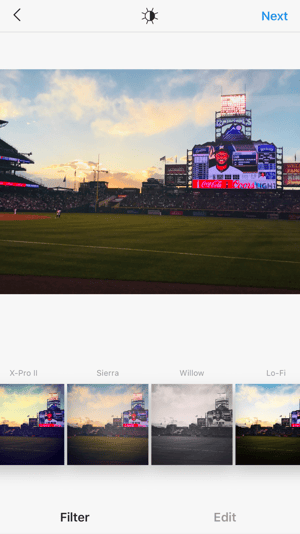
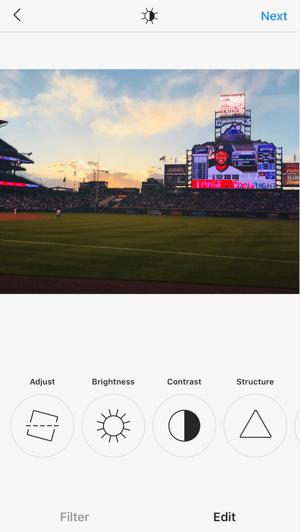
Instagram was founded by Kevin Systrom and Mike Krieger. The two Stanford graduates were pivoting from their original location check-in app, Burbn, due to its similarity to Foursquare. They decided to focus on photo sharing instead and developed the name Instagram as a portmanteau of “instant camera” and “telegram.” Instagram was launched for iOS on Oct. 6, 2010. After almost two years of continuous success, the app was launched for Android phones on April 3, 3012, and was downloaded more than 1 million times in less than a day.
Shortly after, Instagram was acquired by Facebook for $1 billion. Since the acquisition, Instagram has continued to roll out new features. The year 2012 was a big one for the photo-sharing platform, as it also rolled out its website interface in November. The website interface was, and still is, limited in functionality (users are unable to upload photos from a computer – they must use their mobile device). However, it allows users to scroll through their feeds and view other users’ profiles from their desktops.
One of the features that prompted the most chatter and excitement came in June 2013, when Instagram introduced video sharing for the first time. Many speculated that this was to compete with Vine, the short-form video hosting app that was launched in 2012. Video sharing took off quickly and, in 2016, the time limit was increased from 15 seconds to 60 seconds.
In December 2013, Instagram introduced direct private-messaging. These messages can be in photo or text form and can include up to 15 people. However, quite possibly the most notable and controversial updates took place in 2016.
In 2016, Instagram replaced its original logo with a new, more modern and colorful version. The original logo was beige and brown, resembling an old-school, polaroid camera. The revamped purple and orange design took some getting used to. And by that, we mean that we all had to search for at least 30 seconds when trying to find and open the Instagram app.

Additionally, in June of the same year, Instagram switched from its chronological old-to-new newsfeed to an algorithm-based feed. This change was released with the goal of ensuring the content users were seeing was the content they were most interested in. While its intentions were good, this change was met with quite a bit of controversy. Apparently, change is always difficult, even when it’s something as simple as our favorite social media platforms.
That said, one last change in August 2016 has proved to be massively successful – so much so that it gets its own section in this guide!
Instagram released Instagram Stories, a feature that allows users to post photos and videos in a slideshow format that’s only visible to that user’s followers. Similar to Snapchat stories, these disappeared after 24 hours, as opposed to a normal Instagram post (which only disappears if the user or Instagram deletes or archives it). Stories don’t show up in a user’s Instagram grid but, instead, are indicated by a colored circle around the user’s profile picture.
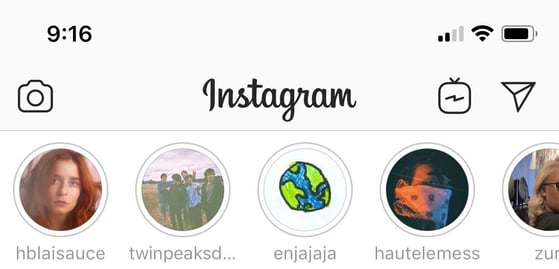
Believe me when I say that leveraging this feature will be more than worth it. They feature the same lighthearted and fun content as Snapchat, without the need to build an entirely new audience on another social networking platform. And, unlike standard Instagram posts that can get lost in your audience’s feed, your Instagram stories is easily accessible sitting right at the top of the app.
Instagram stories are also incredibly interactive. To dress them up, you can write or doodle on the images, place Instagram filters, tag users, and more. You can even ask a poll-type question on Instagram to which your audience can respond. Recently, Instagram rolled out the most interactive feature yet – the ability for your audience to ask you a question that you can then respond to on your Instagram story. If your primary objective is to engage with your audience, then the possibilities are endless.

Unlike a typical Instagram picture, you can see which users are viewing your Instagram story. If you post more than one image or video, creating a series, you can see if they’re clicking through all the way. This is a simple feature that can be massively intuitive.
Say you posted eight images on your Instagram story, but after the third, there was a significant drop off in viewers. You can easily go back to that third image, see what may have gone wrong (Was it boring? Potentially insulting? See? It’s easy to troubleshoot!), and adjust your strategy for next time.
Instagram stories have proved to be invaluable to users, influencers, and marketers alike. Audiences quickly embraced the short-form videos and images. Since its creation, I have yet to open up my Instagram app without seeing a multitude of different users’ Stories stretched across the top of my screen.
Instagram users can also go live on their Instagram Stories, meaning they can post a video that their followers can see in the moment. Think a giant group FaceTime, with video only on one side while others just watch. As far as new features go, this has certainly been one of the most successful. Multiple studies have shown that consumers go nuts over live video. It creates a sense of urgency and truly allows a viewer to feel in the moment.
That’s not all. In its never-ending quest to continue innovating, Instagram launched Instagram TV (IGTV) in June 2018. For the first time, the app offered long-form, vertical video for users to watch and enjoy. IGTV differentiates itself from typical Instagram videos in a few ways. Unlike typical Instagram videos, IGTV videos don’t have a 60-second limit. Most notably, though, is the video’s vertical orientation. Instagram created this feature keeping in mind not just what users watch from their phones, but how.
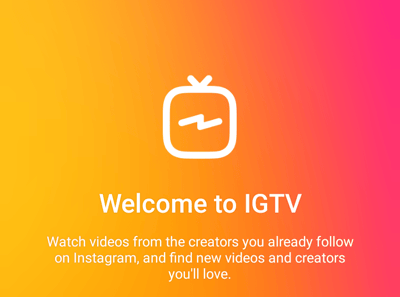
IGTV is also exclusive to well-known and well-liked Instagram creators. Not just anybody can create or post a video on IGTV, making this content even more desirable.
There’s no doubt that Instagram will continue to release new and innovative features. For now, we’ll move on to what this guide is really about – what is Instagram marketing and why do we do it?
TIP: Learn how to leverage IGTV for your business to engage with your social followers.
Now that we know what Instagram marketing is, we have to ask why we should use it?
There are dozens of social media platforms for marketers to choose from, with each and every one offering different features, opportunities, and nuances. For marketers, it’s all about understanding where your audience lives and what platform will enable you to best reach it.
With the growing popularity of Instagram marketing over recent years, the value is clear. If the features we listed above didn’t convince you of Instagram’s appeal, this might: the photo-sharing app recently celebrated 1 billion monthly active users. More importantly, these users are incredibly engaged, with more than 60 percent logging in every single day.
And that’s still not all. In this section, we’ll discuss the various other reasons marketers are flocking to Instagram to reach old and new audiences alike.
Consider learning How to Repost a Video on Instagram to further advance your marketing efforts.
Mentioned above, more than 60 percent of Instagram users are logging in every day. Do you know what that means? Your customers could already be using Instagram to reach you or to talk about your business without you even knowing about it! In fact, 75% of Instagram users take action after seeing a business post. Meaning, they'll maybe search for the product, tell a friend about it, or even buy your product or service.
If you’ve scrolled through your Instagram feed recently, I’d be willing to bet you saw at least one post of a tasty-looking meal from the trendy restaurant that just opened up down the street. In fact, you probably saw many more than just one post like that. It’s a fact – people love sharing their best life on Instagram. I don’t remember the last time I was at brunch where anybody took a single bite of their food before whipping out their phone for a picture.
If you work at an upscale, trendy restaurant or stylish boutique, it’s likely your offering has already been the subject of a customer’s Instagram post! Find more opportunities for engagement by interacting with customers who have tagged you, and don't forget to tag people on Instagram posts you share, too.
These are excellent opportunities to engage with your customers, but they could be wasted if you’re not on the platform on which they’re happening.
Because Instagram has more than 1 billion active users, it's no wonder why people are taking advantage of the advertising opportunity the platform offers.
Did you know that 2.2 percent of Instagram users will interact with an ad. This tops all social media networks, with Facebook coming in second at 0.22 percent. Additionally, by 2020, more than $4.5 billion in mobile ad revenue will be generated by Instagram alone. Other social media networks don’t even come close to this.
Whether you're a small business or a large corporation, learning how to advertise on Instagram will be nothing but beneficial when you're trying to broaden your audience.
Instagram makes it exceptionally easy to reach new audiences.
When you include a hashtag on your post, it creates a link that leads to every post that has been shared with that hashtag. This is why it’s essential to take advantage of hashtags in order to increase your ROI for the platform.
You don’t want to go overboard (between five to 10 hashtags on a given post is a good rule of thumb), but taking advantage of popular and related hashtags will make your brand easier to discover.
I need two hands (and probably some of my toes) to count how many brands I’ve discovered on Instagram, thanks to its use of hashtags and influencer marketing. Something as simple as taking advantage of trending hashtags can be an effective aspect of your Instagram marketing strategy.
If you’re a time-strapped social media marketer (aren’t we all?), you understand the struggle of keeping the content on all of your various social media channels fresh, relevant, and compelling.
This can be even tougher when it comes to sourcing images for your Facebook and Twitter accounts. As marketers, we know that social media users love a post with visuals. In fact, they regularly see more engagement than posts with only text. However, we don’t want to slap up a stock photo with every Facebook status or include a subpar picture in a tweet just for the sake of having an image.
What’s so unique and valuable about Instagram is that it allows you to simultaneously create content for your other marketing channels. You can either save images and repurpose them later or link your Instagram account to your Facebook and Twitter accounts, sharing them directly.
Download The Beginner's Guide to Instagram and get started 🚀
While just about anybody can be found on Instagram, the photo-sharing platform is especially popular among millennials. Nearly 60 percent of 18-to-29-year-olds use Instagram, which is why trendy boutiques and restaurants do so well on the platform. As much as I hate when people say millennials are killing chain restaurants (I still love my Chili’s), I can’t argue that our generation loves to post pictures of a decked out milkshake or the neon sign at Chicago’s most-photographed brunch spot.
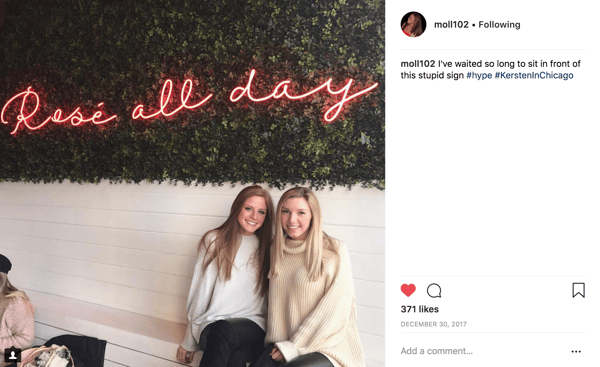
If millennials aren’t your target demographic, don’t shy away from Instagram just yet. Since its launch, the platform has continued to gain popularity among older age groups. In fact, 33 percent of 30-to-49-year-olds and 18 percent of 50-to-64-year-olds are active on the platform – two numbers that iterate the idea that the platform really is for everybody.
Instagram also sees users from various location demographics. Unsurprisingly, 39 percent of adults living in urban areas use Instagram. However, the platform also hosts 31 percent of adults living in rural areas and 28 percent of adults living in suburban areas.
You may be reading this and thinking, “Okay, so it sounds like everybody uses Instagram. Where’s she going with this?”
Well, that’s exactly why I’m saying all of this. In the past, marketers have shown hesitation about implementing an Instagram marketing strategy. Whether it’s because it doesn’t have the same massive user population of Facebook or because it’s not our president’s social media of choice, professionals have strayed away. I’m here to say that if you’re not on Instagram, you are missing out. Your audience is there, and if you don’t reach them, your competitors will.
Listen, there's no universal best time to post on Instagram, but there is a way to discover when your unique brand should be posting. Instagram Insights is a tool you can use to get to know your audience on a deeper level.
By looking at your Insights, you'll find out where your audience lives, how they're discovering you, their age, gender, and how often they're interacting with your account. Additionally, Instagram breaks down what days of the week your profile sees the most traffic and even lets you know which hour of each day is the best to post.
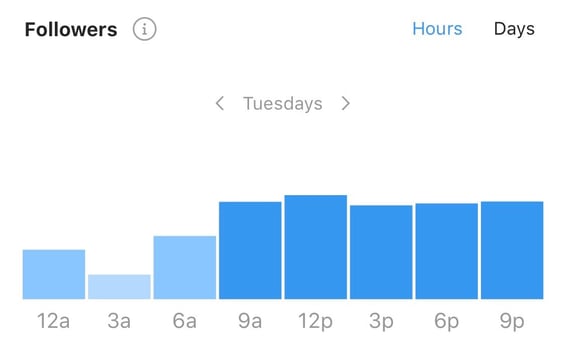
Of course, you should always test out different hours and see how your content performs. The more you experiment, the better you'll be able to determine your best post time. Consider leveraging your Instagram Insights in your next marketing campaign and track your content's progress.
TIP: Learn how to leverage Instagram Shoppable to increase your e-commerce sales in 2019.
A social media marketer knows that before you dive into a new platform, you have to first develop your strategy. Because each platform offers different opportunities and nuances, you can’t assume that what works on one will bring you success on another – no matter how similar they may seem.
With Instagram, building a solid strategy is of the utmost importance. Each post needs to contain a unique combination of an eye-catching photo or video, a compelling caption, and relevant hashtags to help users discover your brand.
TIP: Before diving into your Instagram business strategy, consider taking an online photography course for your business.
The first step is determining what you hope to achieve through this social media platform. Ask yourself what your brand’s purpose will be. Instagram is thrilling in that organizations can use it in tons of different ways, so your options are endless!
Broken down, the steps to creating your Instagram marketing strategy would look like the following:
1. Identify your audience
2. Determine brand goals and objectives
3. Build your team and assign specific roles
4. Establish your brand personality
5. Create your Instagram theme
6. Utilize Instagram Stories
7. Implement a social media calendar
8. Check in on your Instagram Analytics
When you decide what you want to accomplish on Instagram, it's time to create your brand personality, consider your Instagram feed's theme, and implement a social media calendar to keep your content organized. Take a look at our complete guide to developing an Instagram marketing strategy that actually works. Additionally, affiliate Instagram marketing strategies could be a good avenue for you to consider.
Some of the most important data to your unique brand is right under your nose. Instagram Analytics is a free analytics tool within each Instagram business page that tracks metrics such as profile visits, website clicks, reach, and impressions. The tool also collects data that can tell you when your audience is most active, where they live, their age, and their gender.
Your analytics is the data that you reference when you're planning your next Instagram post, Story, or even your next marketing campaign. By diving into this free (yes free) information, you'll better understand how to connect with the people that follow you.
Speaking of content that drives results, let’s talk actual Instagram posts. While every brand that’s successful on Instagram leverages a unique Instagram marketing strategy, there are certain types of posts that have proven to be successful across the board.
In this section, we’ll highlight the types of posts that have proven to be crowd-favorites. These can be customized to fit your specific brand’s typical messaging.
Regardless of your audience, everybody loves good motivational quotes or a feel-good story. In fact, you probably come across these pretty frequently on the ‘gram, and for a good reason! They perform, and they’re pretty easy to put together.
If you choose to build these posts, try your best to make them relevant to your audience. For example, HubSpot is a B2B software company that posts motivational quotes on its profile semi-regularly. While this is a practice that could quickly get tired, HubSpot keeps it fresh by posting quotes focused on business or success (which its audience likely appreciates) and keeping the image itself colorful and eye-catching.
You’ll also see in the example below that it takes advantage of hashtags in a significant way. On this particular post, the hashtags tell the story featuring the phrases #GoalCrusher and #WorkGrind.
Motivational posts don’t always have to be a single quote.
For a story that will resonate with your audience, consider seeking out a customer who has used your product as a means to become successful. Let them use your platform to tell their story. Not only does this humanize your brand and enable you to connect with your audience, but it legitimizes your offering.
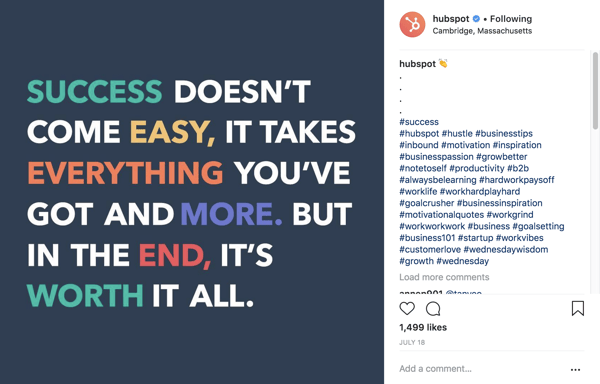
Between finding your subject, capturing photos, editing those photos, and writing your captions, posting to your Instagram can require quite a bit of time and effort.
If you’re looking to simplify this process and get a successful post, look no further than your audience!
If you see somebody has featured your product or service in one of their Instagram posts, you can repost the image to your own account and tag the original poster. This is a win-win – you flatter your customer, engage with them, and get a visually appealing Instagram post without the time spent messing with the contrast and brightness.
Additionally, as more followers see that you share customer posts, they’ll become more likely to feature your product in the future, meaning even more effortless posts for you.
Chicago-based RXBar is my absolute favorite example to use when it comes to reposting customer Instagram posts. Customers love to bring their no-nonsense protein bars with them on their travels, meaning the recognizable packaged snack often ends up in some pretty cool locations. When the customer posts a picture, RXBar will often share the image on its own account, tagging the poster and exposing the image to its 260,000-plus followers.
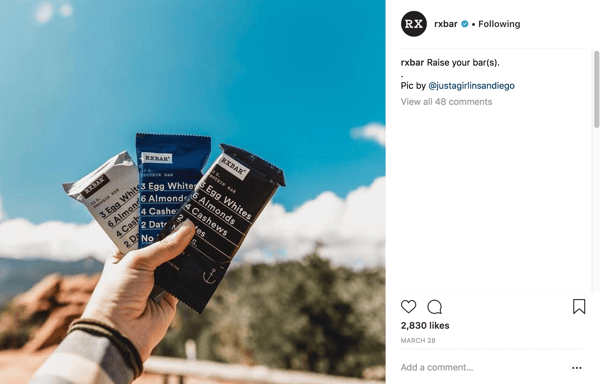
Here at G2 Crowd, we love a good day-in-the-life post. And we’re not the only brand that feels this way.
Showing off your employees on your Instagram can be an essential reminder to potential customers that they’re doing business with people, not with a company. If your goal is to promote your culture, then you definitely want to take advantage of this opportunity. Your audience will enjoy seeing what your employees are up to, and you can even consider letting your employees take the wheel!
At G2 Crowd, we do employee Instagram takeovers on Fridays. For the whole day, one employee is given access to our Instagram account and shows our audience what their typical day looks like. Not only is this a fun way to get employees who aren’t in marketing involved in our social media strategy, but the takeovers have proven very successful regarding gaining followers (you can leverage your employees’ audiences).
Culture posts can show off something as extravagant as your company Christmas party or as simple as your employee’s various workspaces – hopefully, your colleagues don’t have six empty coffee mugs on their desks like I do.

More than anything, this strategy keeps your content compelling by pulling in different people, locations, points of view, events, and more. Your customers are likely wondering about the people working behind-the-scenes. This tactic shows off your stellar team and builds rapport with your audience.
Posts that show off your product or offering were probably the first thought that crossed your mind when introducing your Instagram marketing strategy, and rightfully so. If you’re a B2C brand with an exciting offering, it’s natural to want to show it off to your customers (and, it’s probably what you’re most well-known for).
When it comes to a product post, creativity is critical. Instagram is littered with these, so it’s essential that you feature your product in an eye-catching environment and take a high-quality picture.
Consider this post from B2C giant, Coca-Cola. A bottle of pop isn’t the most interesting photo subject. That said, Coca-Cola built a scene that incorporated the brand’s well-known color scheme and told a story.

If you’re going to show off a product that everybody (and I mean everybody) has seen before, you darn-well better make it interesting – Coca-Cola did just that.
You can also use Instagram to unveil a new product or logo redesign. When Diet Coke changed its logo for the first time since 2007 (can you tell I’m not a Pepsi girl?) and announced three new flavors, it turned to Instagram to tell its customers.
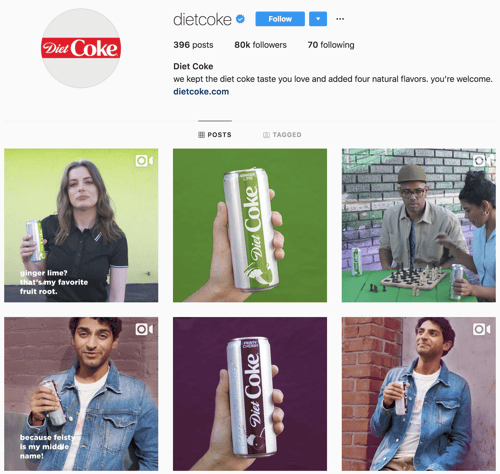
If you’re marketing for a restaurant, don’t even get me started on the opportunities you have in this space. We eat with our eyes first, don’t we? Make your restaurant the talk of the town by sharing your most popular dishes using hashtags to get the word out.
Whether you’re unveiling a new product or showing off your current offering in a new light, always ensure your pictures are well thought out, fit your brand guidelines, and appeal to your audience.
Instagram is creating a new breed of celebrity: the Instagram influencer.
These influencers have revolutionized word-of-mouth marketing. Brands often opt to feature industry-relevant influencers in their social media posts to legitimize their brands, reach new audiences, and connect with their existing fans even further. Influencers can also help brands go viral on Instagram through their large, dedicate followers.
Instagram is an excellent platform on which to connect with various social media influencers and collaborate through Instagram influencer marketing. These social media stars have already built up a following of their own, so these posts typically perform exceedingly well. If you’re interested in connecting with an influencer, consider how other brands in a similar industry have gone about it before. Does the influencer post from their own account? Or, do they do a sort of “takeover” on the brand’s account?
Whichever way you decide to approach this, always remember a few key rules:
Instagram influencers offer a unique opportunity to connect with a new audience, but the relationship comes with its fair share of risks. Be sure to play by the rules and your influencer posts will likely bring you the results you’re hoping for.
There’s a reason Buzzfeed’s Tasty Instagram account has blown up in recent years.
Tasty is a short-form video blog that gives simple and visually compelling recipe tutorials.
Consumers (myself included) love tutorials. If you can show me step-by-step how to turn cauliflower into a pizza in less than 30 seconds, you betcha I’ll take the time to watch the video. More importantly, I’ll be sure to follow you on Instagram to make sure I don’t miss the next one.
The great thing about tutorial posts is that you can personalize them based on your brand’s purpose. Is your organization an online clothing boutique? Consider showing your audience how to style that cute new blouse you just released. If you work for a well-known restaurant, you can show your followers how to recreate your family burger from the comfort of their own home.
These posts should be short, compelling, and educational, keeping your viewer both informed and entertained.
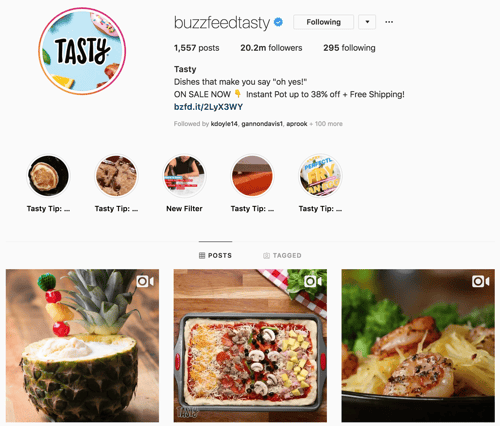
Last, but certainly not least, is any and all video content.
If you’re a social media marketer, I probably don’t even need to say this (but I will).
Consumers love video, and Instagram videos garner more than three times the amount of comments than sponsored Instagram photos.
Enough said.
Now that we’ve hammered home the importance of posting valuable content, we should probably let you in on the secrets behind actually creating that content. In this section, we’ll give you some best practices for curating content that truly performs.
If you’ve developed your Instagram objectives and built out your content themes, you should have a multitude of ideas to turn to when your Instagram profile is in need of some fresh content. That said, it’s not where the hard work ends.
Instagram is a photo-sharing platform. The photo itself is key. You shouldn’t take a picture just to post one, and you certainly shouldn’t post just any picture. When you’ve determined your subject matter, be sure to keep in mind the following photography best practices. I know – it sounds like a lot of work. But I can tell you the brands that are absolutely slaying the Instagram game are taking the time to do this and seeing the results.
When selecting your subject matter, keep one thing in the front of your mind: does my audience want to see this? If the answer is no, then you don’t need to abandon the idea entirely! Just adjust and adapt until it’s a picture that your audience will be interested in. For example, check out this old-school G2 Crowd Instagram post from 2016. Let’s call this the “what not to do.” We had an employee yoga day and were excited to show it off to our Instagram followers! However, selecting a group picture probably wasn’t our best option. The majority of your Instagram audience likely doesn’t know your employees, so this picture was, well, dull.
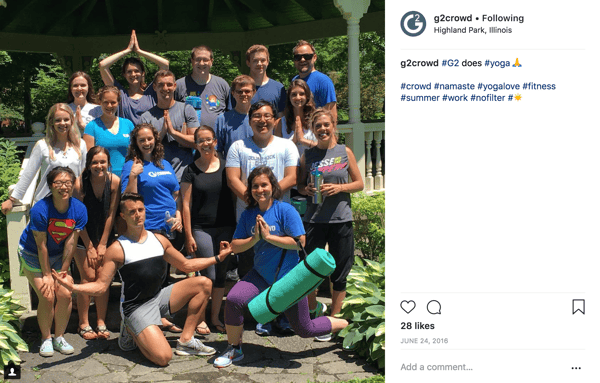
On the other hand, a different brand showed off almost the same subject matter (an employee yoga day) in a much more compelling matter. Check out the example below from Hootsuite, a B2B software tool.
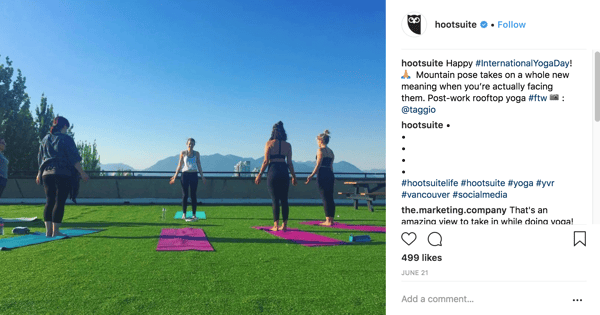
This photo is more colorful, enticing, and all around will appeal to a much larger audience. Showing off employee life is an excellent way to use your Instagram account, but be sure to do so in a way that will still satisfy the wants of your audience.
| TIP: Consider hiring a professional instagram brand ambassador to help grow your online presence. |
When you’re taking pictures for your Instagram (or just for life in general), always remember one thing: the rule of thirds. If you’ve ever taken a photography 101 class, this will probably sound familiar. In fact, I’d be willing to bet it was the first thing you learned!
The rule of thirds is an essential rule in basic photography. The principle behind it is to imagine that your image is broken down into thirds, horizontally and vertically, so that you have a grid containing nine parts.

The rule claims that the primary subject of your image shouldn’t be centered, but, instead, placed at one of the four middle intersections. As an example, consider this picture I took last year on a trip to Seattle. When you place the grid over it, the primary subject (the Public Market sign) is on the intersections instead of centered.

The rule of thirds is a simple way to make your photo more balanced and allows viewers to interact with the subject more naturally. Our eyes are naturally drawn to the interactions, so framing your subject in the center works against our natural inclination.
Already taken pictures that you’d like to repurpose? No worries! There are plenty of apps out there that will enable you to crop and reframe images to fit within the guidelines.
Following this simple rule will make your entire profile more visually enticing, and that’s our end goal, right?
I’m about to tell you the same thing my mother told me nearly every day of my childhood (except for the days where our Chicago suburb didn’t get above 30 degrees).
Go outside!
As often as possible, try to take your pictures in natural light. If it’s absolutely impossible to get outside, shooting your subject near an open window or setting up an indoor lighting kit is a great alternative.
Natural light can be the defining factor in a photo looking high-quality or tacky. If you’re snapping pictures in an office setting, this step is even more critical – those fluorescent overheads aren’t doing anybody any favors.
Once you’ve taken your picture (keeping in mind those best practices, of course), you can edit it to fit the brand guidelines you established earlier. You can use Instagram’s in-platform editor or one of the various smartphone apps. Are you curious about the different apps out there? Be sure to check out our post on the best photo editing apps for your smartphone.
Once your photo is up to your standards and per your established brand guidelines, it’s time to write your Instagram caption!
While Instagram is a photo-sharing platform, that doesn’t mean you can entirely disregard your writing your caption. An effective Instagram caption will encourage engagement, and that’s what we’re always hoping for.
Your Instagram caption can be up to 2,200 characters in length and include up to 30 hashtags. They can also include emojis, but tread cautiously. If your caption is an essay chock full of distracting emojis and irrelevant hashtags, your audience may keep scrolling. As always, consider your audience when putting together your caption. Does this provide more context? Does it encourage interactions from your viewers? If not, you may want to go back to the drawing board.
Experiment with different variations, like asking your audience questions they can answer in the comments or encouraging them to complete a call-to-action. Engagement is key on Instagram, and the more comments and likes your picture receives, the higher in the feed Instagram’s algorithm will place it.
Do you remember those brand guidelines we mentioned? It’s not just your pictures that should adhere to them. When writing your caption, you should always keep in mind the written voice of your brand. What are the typical attributes you associate it with? Whether it’s fun, authoritative, bold, whimsical, or any combination, your Instagram captions should strive to maintain your organization’s tone.
As always, be sure to edit your caption. While social media can be informal, the casual environment doesn't give you an excuse to write a caption with grammatical or spelling errors!
For more on how to write that perfect Instagram caption, check out our best practices guide here.
Additionally, in recent months, Instagram has allowed its users to add Instagram alt text to new and old photos.
As marketers, we’re all about the results. If every single one of our efforts isn’t pushing the needle on a company goal, then what’s the point?
Measuring success with your social media campaigns is especially important, as success looks different on every platform. In this section, we’ll highlight some important Instagram metrics that will help you determine whether your strategy is working toward your objectives or falling flat.
Boasting a large Instagram following can be a great indicator of your organization’s success on the platform. If that number doesn’t continue to grow, though, you may not be expanding your reach quite as much as you’d like to be.
On a similar note, most people may think that if you don’t have a lot of followers, you aren’t doing well. That may be true in some cases, but if you have a high growth rate, you could be well on your way to success. That’s why tracking growth rate is just as important (if not more so) as your actual number of followers.
Your follower growth rate is a percentage that you can calculate by dividing how many new followers you get over a period of time (let’s say a month) by how many followers you had at the beginning of that period.
As an example, let’s say you started in April 2018 with 1,200 Instagram followers. Throughout the month of April, your profile gained 120 followers (for the sake of a simple equation). Your growth rate would come out to be 10 percent, which is excellent! On the other hand, if your account only gained 30 followers over the month, your growth rate would be 2.5 percent, which could indicate that your reach is stagnating.
Learn more about How to Get More Followers on Instagram.
Getting a ton of likes per post is flattering, sure, but when it comes to Instagram, comments are key.
Why is that?
Comments indicate engagement, which is our primary goal. Anybody can double-tap a picture, but it takes time to think through and type out a comment. If a follower is willing to spend that time on your organization, then congratulations! Your content resonated with them.
More importantly, Instagram’s algorithm recognizes comments as a stronger engagement than likes. And because Instagram’s algorithm ranks posts in its feed based on levels of engagement, receiving more comments will lead to your post being higher up in your followers’ feeds.
As we mentioned above, followers are an important metric, but they aren’t the end-all-be-all of your Instagram marketing strategy.
If you have a large following, but not a ton of likes or comments on your posts, you could be in trouble. That’s why we look at the metric that tells you your engagement relative to the size of your audience – engagements per follower.
To calculate your engagements per follower, divide the number of likes or comments on a post by the number of followers you had at the time of that post.
Calculate your engagements per follower ratio semi-regularly overtime to see if your engagement rate is growing. If so, congratulations! Not only is your page resonating with your followers, but it’s becoming a priority to them, as they’re continuing to come back and interact with your content.
This metric is a bit more complicated, as there are a few ways you can look at this number.
Whenever you post an Instagram story, be sure to check how many people are viewing it. If you post more than one, then it’s also important to see how many people are clicking all the way through it. If 100 people view the first slide of your Instagram story, but only 10 people click all the way through to the end, there’s probably something you could improve for next time.
Additionally, you can see how many followers are interacting when you post poll-like questions or how many questions you’re being asked when you give your followers the opportunity. You can look at these engagements based on your total number of followers, or based on the total amount of people viewing your story.
I hope this guide left you feeling well-informed on Instagram and its multitude of opportunities for marketers.
This is just one of the many types of marketing. Don't forget about the other social media platforms! Whether you're a novice social media marketer or years into your career, you won't want to miss our comprehensive resource.
Claire is a former growth marketing team manager at G2. Born and raised in the Chicago area, her brief stint in Ohio (University of Dayton) gave her a new appreciation for deep-dish pizza, but left her well-versed in Cincinnati-style chili and "cities" with a population fewer than 400,000. While not writing, Claire can be found practicing calligraphy, seeking out the best dive bars in Chicago, and planning her next trip. (she/her/hers)
Everyone knows what Instagram is. Come on, it’s 2019.
 by Alexa Drake
by Alexa Drake
In our current social media era, influencer marketing is more prevalent than ever.
 by Alexa Drake
by Alexa Drake
Everyone knows what Instagram is. Come on, it’s 2019.
 by Alexa Drake
by Alexa Drake



